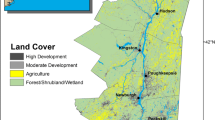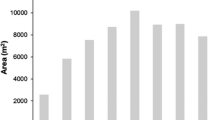Abstract
Baccharis halimifolia L. (Asteraceae) is a shrub native to North America which is invading estuarine communities in Europe. We report the invasion history and the distribution limits of B. halimifolia in Europe, with particular emphasis on the frequency of its presence in estuarine communities in Spain. B. halimifolia has been cultivated in Europe since the 17th century to present. It was first recorded as naturalized in the Bay of Biscay in 1906, where it forms currently stable and locally abundant populations in almost all the estuaries of Northern Spain and Western France. The ongoing invasion to the west could reach well conserved estuarine communities in Galicia (Spain). B. halimifolia also forms scattered populations in Northern and Southern France, Belgium, Netherlands, United Kingdom and Italy. In these countries it has experienced a rapid expansion during the last years. In Northern Spain, subhalophilous communities dominated by rush (Juncus maritimus) and/or sea couch (Elytrigia atherica), common reed stands (Phragmites australis) and ungrazed wet meadows are the most vulnerable to invasion. The subhalophilous communities are part of natural habitats of community interest according to the habitats directive 92/43/EEC. In some areas of Northern Spain these communities have been totally replaced by monospecific stands of B. halimifolia. In contrast, halophilous communities of the low marsh are resistant to invasion, suggesting that the survival of B. halimifolia may be limited by threshold values of salinity and waterlogging. With this study we want to raise awareness about the risk of replacement of estuarine subhalophilous communities by the ongoing invasion of B. halimifolia in Europe.


Similar content being viewed by others
References
Allorge P (1941) Essai de synthèse phytogéographique du Pays Basque. Bull Soc Bot France 88:291–356
AME-CBNMP (2003) Plantes envahissantes de la région méditerranéenne. Agence Méditerranéenne de l’Environnement, Agence régionale pour l’environnement Provence-Alpes-Côte d’Azur
Arrigoni PV, Viegi L (2011) La flora vascolare esotica spontaneizzata della Toscana. Direzione generale Politiche territoriali, ambientali e per la mobilità, Firenze
Barriocanal CJ, Font J, Oliver X, Rotllan C (2005) Baccharis halimifolia L. al Baix Empordà. Butll Inst Catalana Hist Nat 73:115–116
BioCase Data Portal, www.biocase.org. Accessed December 2011
Biurrun I, García-Mijangos I, Campos JA, Herrera M, Loidi J (2012) Vegetation-plot database of the University of the Basque Country (BIOVEG). In: Dengler J, Oldeland J, Jansen F, Chytrý M, Ewald J, Finckh M, Glöckler F, Lopez-Gonzalez G, Peet RK, Schaminée JHJ (eds) Vegetation databases for the 21st century. Biodivers Ecol 4:89–94
Campos JA (2010) Flora alóctona del País Vasco y su influencia en la vegetación. Dissertation, University of the Basque Country. UPV/EHU
Campos JA, Herrera M, Biurrun I, Loidi J (2004) The role of alien plants in the natural coastal vegetation in central-northern Spain. Biodivers Conserv 13(12):2275–2293
Coste HJ (1906) Flore descriptive et illustrée de la France, de la Corse et de contrées limitrophes. Tome troisième, Paris
Doody JP (2008) Management of Natura 2000 habitats. 1330 Atlantic salt meadows (Glauco-Puccinellietalia maritimae). European Commission
Dupont P (1952) Sur l’extension en Bretagne de Baccharis halimifolia L. Bull Soc Sci Bretagne 27:109–111
Espinar JL (2009) 1330 Pastizales salinos atlánticos (Glauco-Puccinellietalia maritimae). V.V.A.A., Bases ecológicas preliminares para la conservación de los tipos de hábitat de interés comunitario en España. Ministerio de Medio Ambiente y Medio Rural y Marino, Madrid
GEIB (2006) TOP 20: Las 20 especies exóticas invasoras más dañinas presentes en España. GEIB, Serie Técnica N.2. León
González Costales JA (2007) Plantas alóctonas invasoras en el Principado de Asturias. Consejería de Medio Ambiente, Ordenación del Territorio e Infraestructuras y Obra Social “la Caixa”. Oviedo
Grillas P (1998) Programme de lutte contre les espéces exotiques envaissantes dans les espaces protegés du Languedoc-Rousillon. Unpublished Report. Station Biologique Tour du Valat, Perpignan
Guinea E (1953) Geografía botánica de Santander Public. Exma. Diputación Provincial de Santander, Santander
Herrera M (1985) Estudio de la vegetación y flora vascular de la cuenca del río Asón (Cantabria). Guineana 1:1–435
Herrera M, Campos JA (2010) Flora alóctona invasora en Bizkaia. Instituto para la sostenibilidad de Bizkaia. Diputación Foral de Bizkaia, Bilbao
Hobbs R, Mooney H (1987) Leaf and shoot demography in Baccharis shrubs of different ages. Am J Bot 74(7):1111–1115
Jovet P (1941) La végétation antropophile du Pays Basque Français. Bull Soc Bot Fr 254–269
Miller P (1807) The gardener’s and botanist’s dictionary. London
Muller S (2004) Plantes invasives en France: état des connaissances et propositions d’actions, vol 62. Publications Scientifiques du Muséum National d’Histoire Naturelle, Paris
Onaindia M, Navarro C (1987) Vegetación de las marismas de Vizcaya. Munibe 39:75–80
Parsons WT, Cuthbertson EG (1992) Noxious weeds of Australia. Inkata Press, Melbourne
Rappé G, Verloove F, Van Landuyt W, Vercruysse W (2004) Baccharis halimifolia (Asteraceae) aan de Belgische kust. Dumortiera 82:18–26
Riviére P (1916) Observations. Le Monde des Plantes: Intermédiaire des Botanistes 98: 2
USDA, NRCS (2012) The PLANTS Database (http://plants.usda.gov, 8 June 2012). National Plant Data Team, Greensboro, NC 27401-4901, USA
Verloove F (2007) La flore urbaine de Dunkerque (Nord): quelques xenophytes remarquables. Le Monde des Plantes: Intermédiaire des Botanistes 494:11
Westman WE, Panetta FD, Stanley TD (1975) Ecological studies on reproduction and establishment of woody weed, groundsel bush (Baccharis halimifolia L.: Asteraceae). Aust J Agr Res 26(5):855–870
Young DR, Erickson DL, Semones SW (1994) Salinity and the small-scale distribution for 3 barrier-island shrubs. Can J Bot 72(9):1365–1372
Acknowledgments
We are grateful to Charo Noya (Real Jardín Botánico de Madrid), Cristina Villani (University of Padova), Filip Verloove (National Botanic Garden of Belgium), Johan van Valkenburg (Plant Protection Service The Netherlands), Catherine Zambettakis and Fabien Dortel (Conservatoire Botanique National de Brest) and Tour du Valat Research Center staff for their help with information compilation and to Patrick McIntyre and Ivalú Cacho for valuable comments on the manuscript. This research has been funded by the program “Ayudas para la Especialización de Personal Investigador” and Cátedra UNESCO grant (09/17) of the University of the Basque Country, by IT-247-07 grant of the Basque Government and the CGL2009-13317-C03-02 grant of the Spanish Ministry of Science and Innovation.
Author information
Authors and Affiliations
Corresponding author
Rights and permissions
About this article
Cite this article
Caño, L., Campos, J.A., García-Magro, D. et al. Replacement of estuarine communities by an exotic shrub: distribution and invasion history of Baccharis halimifolia in Europe. Biol Invasions 15, 1183–1188 (2013). https://doi.org/10.1007/s10530-012-0360-4
Received:
Accepted:
Published:
Issue Date:
DOI: https://doi.org/10.1007/s10530-012-0360-4




